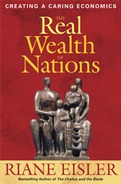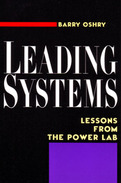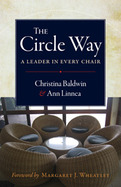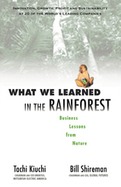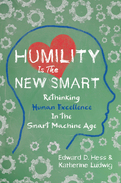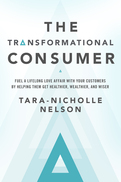- From the author of the bestselling classic The Chalice and the Blade (over 500,000 sold)
- Proposes a dramatic new economic model that could help resolve many of the most critical problems we face today
- Offers concrete steps for putting this model into practice
2004
For over thirty years, Barry Oshry has uncovered core truths about how we operate in large organizations through the Power Lab, an experiential program that has been called "The World Series of Leadership Development Activities." In Leading Systems, Oshry reveals the lessons he has derived from his Power Lab experiences-experiences that have been central to his innovative insights about human systems and system leadership.
Oshry maintains that the next evolutionary challenge for human beings is to recognize ourselves as system creatures, see how system processes shape our experiences, and develop the knowledge and skills to master these processes rather than be victims of them. Drawing on his Power Lab experiences, he reveals the possibilities of systems leadership and how effective leadership can provide the basis for creating sane, healthy, effective social systems.
Challenging conventional thinking, Oshry shows the limitations of consensus, the importance of unilateral action, and the restrictions that our values-such as egalitarianism, liberalism, conservatism-can place on power. He reveals how the problems we often believe are personal or peculiar to our system or circumstances are in fact systemic, limiting the possibilities of both individuals and the system as a whole-and he demonstrates what it takes to break out and elevate ourselves and our systems to higher levels of possibility.
Perhaps most importantly, Oshry shares his experience in discovering what he calls "exhilarating concepts," and shows how these concepts offer unusual insights into the nature of systems, shedding light on everything from organizational dysfunction to the conflicts that occur along lines of race, gender, sexual orientation, and ethnicity. It is only through this deep knowledge, Oshry says, that system leaders can elevate their systems to those higher levels of possibility to which we aspire.
Offering new directions, Leading Systems is essential reading for anyone who wants a deep understanding of how systems work and how to exert enlightened leadership.
- Accessible, full of real-life examples, and beautifully written by a pioneer in systems thinking
- A systems framework based not on hopes and dreams but on thirty years of research on what systems really are
- Speaks to leadership in the family, community, organization, and nation
2010
- Demonstrates that nature provides a powerful business model for driving innovation, increasing profit, spurring growth, and ensuring sustainability
- Includes real-life examples from such leading companies as Coca-Cola, Intel, Coors, Nike, Ford, DuPont, 3M, and more
- Written by two would-be "arch enemies": a hard-nosed CEO of a major corporation and a dedicated environmentalist
- Doesn't just balance competing interests-it integrates them in a new paradigm
Smart machines are replacing more and more jobs. Edward Hess and Katherine Ludwig show how to develop abilities that machines don't have so we can thrive in this Smart Machine Age. Underlying them all is a sense of personal humility: honestly recognizing our limitations and working to mitigate them.
In nearly every industry, smart machines are replacing human labor. It's not just factory jobs-automated technologies are handling people's investments, diagnosing illnesses, and analyzing written documents. If we humans are going to endure, Edward Hess and Katherine Ludwig say we're going to need a dose of humility.
We need to be humble enough to let go of the idea that smart means knowing the most, using that information quickest, and making the fewest mistakes. Smart machines will always be better than we are at those things. Instead, we need to cultivate important abilities that smart machines don't have (yet): thinking critically, creatively, and innovatively and building close relationships with others so we can collaborate effectively. Hess and Ludwig call this being NewSmart.
To develop these abilities, we need to practice four specific behaviors: keeping our egos out of our way, managing our thoughts and emotions to curb any biases or defensiveness, listening to others with an open mind, and connecting with others socially and emotionally. What all these behaviors have in common is, again, humility-avoiding self-centeredness so we can learn from and work with other humans. Hess and Ludwig offer a guide to developing these NewSmart abilities and to creating organizations where these qualities are encouraged and rewarded.
They are the most valuable, least understood customers of our time. They buy over $4 trillion in life-improving products and services every year. If you serve their deeply human need to continually improve their lives, they will eagerly engage with your brand at a time when most people are tuning out corporate messages.
They are Transformational Consumers, and no one knows them like Tara-Nicholle Nelson. Her Transformational Consumer insights powered her work at MyFitnessPal, which grew from 40 million to 100 million users in her time there.
Nelson takes readers on a hero's journey to connecting with customers in ways both profitable and transformational. After going inside the brains, emotions, and behaviors of Transformational Consumers, Tara issues a call to adventure: a rallying cry to leaders to shift their focus from simply making products to solving their customers' problems.
Nelson uses stories and cases studies from every industry to guide readers through this journey in five stages, shedding light on how to rethink their customers, their products and services, their marketing, their competition, and even their culture.
The key to growing a business today is not building an app or getting new social media followers. The key is engaging people over and over again by triggering their deep, human desire for growth and transformation.
When a company reorients every initiative to serve Transformational Consumers, it kick-starts a lifelong love affair with its customers—a love affair that results in unprecedented revenue growth, product innovation, and employee engagement.


